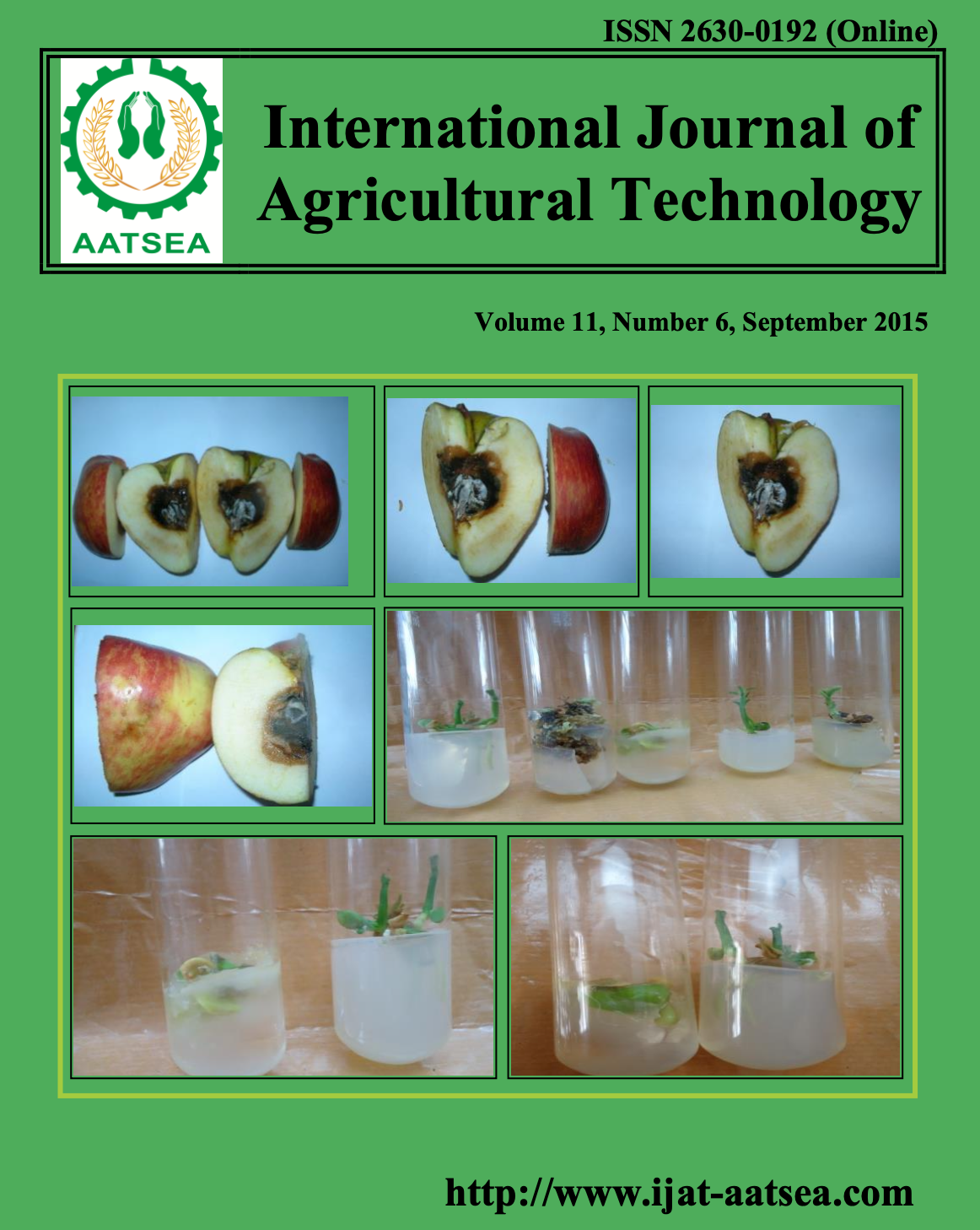Effects of Schizochytrium sp. on growth performance and survival rate of Giant Freshwater Prawn, Macrobrachium rosenbergii (De Man)
Main Article Content
Abstract
Article Details

This work is licensed under a Creative Commons Attribution-NonCommercial-NoDerivatives 4.0 International License.
References
AOAC (2005). Official methods of analysis, 18th edn. Association of official analytical chemists, Arlington. USA: AOAC International.
Barclay, W., Weaver, C. and Metz, J. (2005). Development of a docosahexaenoic acid production technology using Schizochytrium: a historical perspective. In: Cohen, Z., Ratledge, C. (Eds.), Single Cell Oils., Champaign, IL: AOCS Press. pp. 36-52.
Barlow, S. (2000). Fish oil. Glob. Aquacuture. Advocate 3:85-88.
Behrens, P. W. and Kyle, D. J. (1996) Microalgae as a source of fatty acids. Journal of Food Lipids 3:259-272.
Catacutan, M. R. (1991). Growth and fatty acid composition of Penaeus monodon juveniles fed various lipids. Bamidgeh 43:47-56.
Carter, C. G., Bransden, M. P., Lewis, T. E. and Nichols, P. D. (2003). Potential of thraustochytrids to partially replace fish oil in Atlantic salmon feeds. Journal of Marine Biotechnology 5:480-492.
Colvin, P. M. (1976). The effect of selected seed oils on the fatty acid composition and growth of Penaeus indicus. Aquaculture 8:81-89.
Deering, M. J., Fielder, D. R. and Hewitt, D. R. (1997). Growth and fatty acid composition of juvenile leader prawns, Penaeus monodon. Aquaculture 151:131-141.
Food and Agriculture Organization of the United Nations. (2005). Fishstat plus: Universal Software for Fishery Statistical Time Series.Version 2.3.
FAO Fisheries Department, Fishery Information, Data and Statistics Unit. FAO, Rome.
FAO FishStatJ. (2013). Fisheries and Aquaculture Department, Statistics and Information 957 Service FishStatJ: Universal software for fishery statistical time series. Copyright 958 2011.Version 2.1.0.
Garling, D. L. and Wilson, R. P. (1976). Optimum dietary protein to energy ratio for Channel catfish fingerlings Ictalurus punctatus. The Journal of Nutrition 106:1368-1375.
Grasshoff, K. (1976). Methods of seawater analysis. Verlag Chemie: Weinheim.
Ganuza, E., Anderson, A. J. and Ratledge, C. (2008). High-cell-density cultivation of Schizochytrium sp. in ammonium–pH-auxostat fed-batch system. Biotechnology Letters 30:1559-1564.
Gonzalez-Fe lix, M. L., Lawrence, A. L., Gatlin III, D. M. and Perez-Velazquez, M. (2002). Growth, survival and fatty acid compostion of juveniles Litolitopenaeus vannamei fed different oils in the presence and absence of phospholipids. Aquaculture 205:325–343.
Guary, J. C., Kayama, K., Murakami, Y. and Ceccaldi, H. J. (1976). The effect of a fat-free diet and compounded diets supplemented with various oils on molt, growth and fatty acid composition of prawn, Penaeus japonicus. Aquaculture 7:245-259.
Harel, M., Koven, W., Lein, I., Bar, Y., Behrens, P., Stubblefield, J., Zohar, Y. and Place, A. R. (2002). Advanced DHA, EPA and ArA enrichment materials for marine aquaculture using single cell heterotrophs. Aquaculture 213:347-362.
Harrison, K. E. (1990). The role of nutrition in maturation, reproduction and embryonic development of decapod crustaceans: A review. Journal of Shellfish Research 9:1-28.
Langdon, C. and Onal, E. (1999). Replacement of living microalgae with spray-dried diets for the marine mussel, Mytilus gallo- prouincialis. Aquaculture 180:283-294.
Li, M. H., Robinson, E. H., Tucker, C. S., Manning, B. B. and Khoo, L. (2009). Effects of dried algae Schizochytrium sp. a rich source of docosahexaenoic acid, on growth, fatty acid composition and sensory quality of channel catfish, Ictalurus punctatus. Aquaculture 292:232-236.
Lim, C., Ako, H., Brown, C. L. and Hahn, K. (1997). Growth response and fatty acid composition of juvenile Litopenaeus vannamei fed different sources of dietary lipid. Aquaculture 151:143-153.
Miller, M. R., Nichols, P. D. and Carter, C. G. (2007). Replacement of dietary fish oil for Atlantic salmon parr (Salmo salar L.) with a stearidonic acid containing oil has no effect on omega-3 longchain polyunsaturated fatty acid concentrations. Comparative Biochemistry and Physiology - Part B: Biochemistry & Molecular Biology 146:197-206.
Patnaik, S., Samocha, T. M., Davis, D. A., Bullis, R. A. and Browdy, C. L. (2006). The use of algal meals as highly unsaturated fatty acid sources in practical diets designed for Litopenaeus vannamei. Aquaculture Nutrition 12:395-401.
Reigh, R. C. and Stickney, R. R. (1989). Effects of purified dietary fatty acids on the fatty acid composition of freshwater shrimp Macrobrachium rosellbergii. Aquaculture 77:157-174.
Sheen, S. S. and Wu, S. W. (1999). The effect of dietary lipid levels on the growth response of juvenile mud crab, Scylla serrata. Aquaculture 175:143-153.
Van Hoestenberghe, S., Fransman, C. A., Luyten, T., Vermeulen, D., Roelants, I., Buysens, S. and Goddeeris, B. M. (2014). Schizochytrium as a replacement for fish oil in a fishmeal free diet for jade perch, Scortum barcoo (McCulloch&Waite). Aquaculturem Research 1-4.
Vasagam, K. P. K., Ramesh, S. and Balasubramanian, T. (2005). Dietary value of different vegetable oil in black tiger shrimp Penaeus monodon in the presence and absence of soy lecithin supplementation: effect on growth, nutrient digestibility and body composition. Aquaculture 250:317-327.
Wen, X. B., Chen, L. Q., Zhou, Z. L., Ai, C. X. and Glenn, Y. D. (2002). Reproduction response of Chinese mitten-handed crab (Eriocheir sinensis) fed different sources of dietary lipid. Comparative Biochemistry and Physiology - Part A 131:675-681.
Zhou, Q. C., Li, C. C., Liu, C. W., Chi, S. Y. and Yang, Q. H. (2007). Effects of dietary lipid sources on growth and fatty acid composition of juvenile shrimp, Litopenaeus vannamei. Aquaculture Nutrition 13:222-229.


